My Top 10 Favorite Imaginary Settings (Part I)
My recent retrospectives of both Dragonlance Adventures and Greyhawk Adventures got me thinking about my favorite settings for roleplaying games, which, in turn, got me to thinking about my favorite imaginary settings in general. Before long, I realized that I had the makings of a couple of posts in which I listed, in order, my favorite imaginary settings, along with some thoughts on how I first encountered them and why I still like them. Like all my previous lists of this sort, this one is intentionally personal. It's not intended to pass judgment on these or any other imaginary settings in any absolute sense. If your favorite isn't to be found here, that only means that you and I have different tastes, nothing. I doubt there will be many surprises here for long-time readers, except perhaps the order in which I rank the various settings I've chosen.
10. Middle-earth
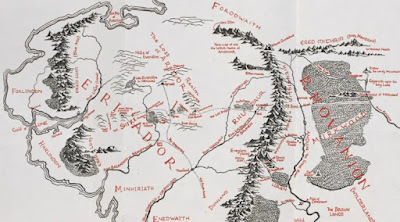 Growing up in the 1970s, J.R.R. Tolkien's Middle-earth was probably the most well-known example of literary fantasy in popular culture. The Rankin-Bass cartoon of The Hobbit was released in 1977, with Ralph Bakshi's The Lord of the Rings coming out the following year. This is also the decade of the Brothers Hildebrandt Tolkien calendars and the Ballantine paperbacks with covers featuring Tolkien's own artwork. Consequently, it would have been nigh impossible for me not to have been pulled into the orbit of one of greatest fantasy settings of all time.
Growing up in the 1970s, J.R.R. Tolkien's Middle-earth was probably the most well-known example of literary fantasy in popular culture. The Rankin-Bass cartoon of The Hobbit was released in 1977, with Ralph Bakshi's The Lord of the Rings coming out the following year. This is also the decade of the Brothers Hildebrandt Tolkien calendars and the Ballantine paperbacks with covers featuring Tolkien's own artwork. Consequently, it would have been nigh impossible for me not to have been pulled into the orbit of one of greatest fantasy settings of all time. Tolkien invested Middle-earth with a richness of detail that has, I think, become a model for every creator who's followed in his wake, even those who explicitly reject his particular take on fantasy. I know that's true in my own case, which is why I include the setting in this list. However, my fondness for Middle-earth is a distant and somewhat cold one – respect might be a better word to describe it. There's much I admire about Tolkien's creation, but very little I've directly emulated in my own (admittedly paltry) efforts, hence why I rank it lower than every other setting I'll discuss.
9. Barsoom
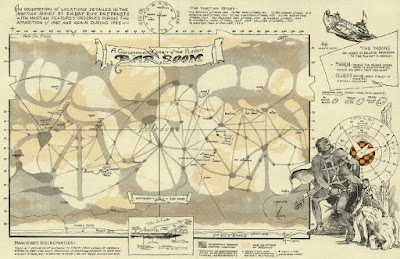 Mars, as envisioned by Edgar Rice Burroughs, is one of the oldest science fiction – or fantasy; take your pick – settings of lasting significance, inspiring innumerable writers (and scientists) to consider what life might be like on planets other than our own. I can't quite recall when I was first exposed to Barsoom, but it's been a setting I've loved for almost as long as I can remember. In my younger days, I simply thrilled to the exploits of John Carter, as he struggled mightily against a wide variety of nefarious antagonists, none of whom possessed an ounce of his courage or honor. Nowadays, I'm much more interested in Burroughs's worldbuilding, which is surprisingly rich and deep.
Mars, as envisioned by Edgar Rice Burroughs, is one of the oldest science fiction – or fantasy; take your pick – settings of lasting significance, inspiring innumerable writers (and scientists) to consider what life might be like on planets other than our own. I can't quite recall when I was first exposed to Barsoom, but it's been a setting I've loved for almost as long as I can remember. In my younger days, I simply thrilled to the exploits of John Carter, as he struggled mightily against a wide variety of nefarious antagonists, none of whom possessed an ounce of his courage or honor. Nowadays, I'm much more interested in Burroughs's worldbuilding, which is surprisingly rich and deep.Barsoom is a great example of an adventuresome setting, by which I mean one where almost every detail exists to provide fodder for tales of derring-do. That undoubtedly limits the scope of Barsoom somewhat, but I can't say that bothers me much. Sometimes, all you want out of an imaginary setting is a fun environment for exciting stories and Barsoom provides that in spades. Considering the importance of the Red Planet to the creation of the hobby, I'm not the only person who thinks so.
8. The Known Worlds of Fading Suns
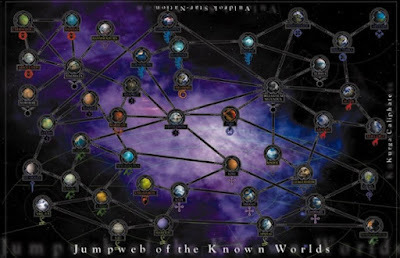 This is the first (but not the last) roleplaying game setting to appear on this list and with good reason. Since its appearance in 1996, I've enjoyed the 51st century of this "futuristic passion play," both as a referee and as a writer. Much like Barsoom, the Known Worlds are an adventuresome setting, perhaps even more explicitly so, since it was created for use in roleplaying game campaigns. This means that (also like Barsoom), the setting doesn't stand up to close scientific scrutiny, despite the fact that it's supposed to take place thousands of years from now in our world. It's closer to a fantasy setting in many ways and I have found that most objections to one or another aspect of it are best met by explaining that.
This is the first (but not the last) roleplaying game setting to appear on this list and with good reason. Since its appearance in 1996, I've enjoyed the 51st century of this "futuristic passion play," both as a referee and as a writer. Much like Barsoom, the Known Worlds are an adventuresome setting, perhaps even more explicitly so, since it was created for use in roleplaying game campaigns. This means that (also like Barsoom), the setting doesn't stand up to close scientific scrutiny, despite the fact that it's supposed to take place thousands of years from now in our world. It's closer to a fantasy setting in many ways and I have found that most objections to one or another aspect of it are best met by explaining that.On the other hand, the Known Worlds are almost unique among futuristic settings in the pride of place they give to philosophy, religion, and spiritual matters. This is a setting, like Frank Herbert's Dune, that recognizes that mankind will bring religion with him as it travels the stars and, if anything, will only become more influential because of it. That's catnip for people like myself, who take great interest in questions of this kind, especially since the setting isn't interested in providing answers to those questions but rather occasions to ask more of them against a back of interstellar adventure.
7. The Hyborian Age
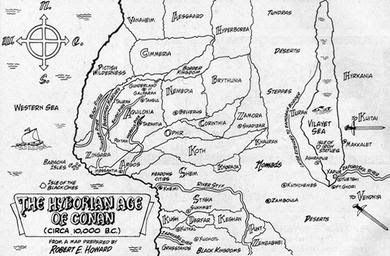 The 1970s was also the decade in which the works of Robert E. Howard managed to break into popular culture, thanks in no small part to Marvel's Conan the Barbarian comic book series. Though I of course read the comics, I was even more devoted to the short stories and novellas that I found on a spinner rack in my local library. Through them I became acquainted with the prehistoric Hyborian Age in which the Cimmerian lived. A heady mix of real world history and Howard's own flights of fancy, the Hyborian Age was simultaneously familiar and alien to me, which made it all the easier for my youthful self to fall in love with it.
The 1970s was also the decade in which the works of Robert E. Howard managed to break into popular culture, thanks in no small part to Marvel's Conan the Barbarian comic book series. Though I of course read the comics, I was even more devoted to the short stories and novellas that I found on a spinner rack in my local library. Through them I became acquainted with the prehistoric Hyborian Age in which the Cimmerian lived. A heady mix of real world history and Howard's own flights of fancy, the Hyborian Age was simultaneously familiar and alien to me, which made it all the easier for my youthful self to fall in love with it. My appreciation for the setting only grew with age. I read REH's own essay about the Hyborian Age and his thoughts on its creation and immediately understood what I had only dimly grasped previously, namely, that real world history and cultures could be used to create something that nevertheless felt fresh and exciting. There is no need to create entire worlds from whole cloth, nor is there any shame in borrowing from the examples of the past. The trick is in using these raw materials imaginatively, as Howard had done, to present something that was a compelling back drop for adventure.
6. The Dying Earth
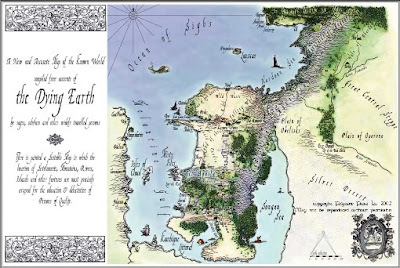 I've often said that science fiction is my natural medium. Despite that, I've spent more time roleplaying in fantasy worlds than in science fiction ones. Given that, I suppose it was inevitable that I'd fall in love with Jack Vance's Dying Earth. Set untold eons in the future, the Dying Earth is a setting in which science has become indistinguishable from magic and has changed the face of the planet – and its inhabitants – forever. In some ways, it's an ideal setting for someone with my conflicting interests and experiences, allowing me to have my cake and eat it too, so to speak. (I'm sure the fact that D&D's magic system is based on that of the setting endeared it to me as well.)
I've often said that science fiction is my natural medium. Despite that, I've spent more time roleplaying in fantasy worlds than in science fiction ones. Given that, I suppose it was inevitable that I'd fall in love with Jack Vance's Dying Earth. Set untold eons in the future, the Dying Earth is a setting in which science has become indistinguishable from magic and has changed the face of the planet – and its inhabitants – forever. In some ways, it's an ideal setting for someone with my conflicting interests and experiences, allowing me to have my cake and eat it too, so to speak. (I'm sure the fact that D&D's magic system is based on that of the setting endeared it to me as well.)The other thing I adore about the Dying Earth is its overall feel: cynical, exhausted, and mysterious. You never know what you're going to find over the next hill or whether the traveler with an extra-broad smile you meet on the road is a friend or a foe. It's a place that keeps you guessing, sometimes until it's too late to extricate yourself from the trouble in which you've now found yourself. It's the stuff of enjoyable stories and captivating adventures.
James Maliszewski's Blog
- James Maliszewski's profile
- 3 followers



